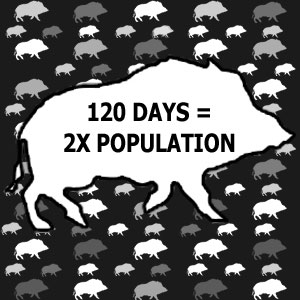
America’s got a big problem—a big wild pig problem. Just 24 years ago, the U.S Department of Agriculture found some 1 million wild pigs roamed the American landscape, the vast majority of those found in Florida and Texas. Today? USDA estimates at least 5 million wild porkers spread out over 37 of the 50 states!
Some are descendants of hogs imported to the New World by Spanish explorers nearly 500 years ago. Some were once domesticated farm pigs that got loose and went feral or wild. Others are game farm escapees.
Wherever they come from, wild hogs come with a huge price tag—at least $1 billion a year, both in the damage the pigs do and the money we spend to control them. Wild pigs are a major thorn in the side of American farmers and ranchers, tearing up pastures and uprooting crops, and helping to spread up to 30 diseases and 37 parasites to livestock, people and pets.
Wild hogs harm wildlife, too, destroying the nests of turkey and quail, damaging wildlife habitats with their constant rooting, and directly competing with deer and other game species for forage like acorns, nuts and berries.
More pig hunting can only help, and the growing trend of tactical pig hunting promises to reduce pig populations even further.
Yes, game managers and wildlife experts will tell you there is no one solution to American wild hog problem. Like many invasive species, wild pigs don’t just survive, they thrive, and once established can be almost impossible to get rid of. Trapping and other lethal methods, by government agencies, farmers, and professional animal controllers all have their place.
But the big downside to these control methods? Cost. One media report places the total annual bill for all wild hog damage and control efforts in Texas alone at $400 million. It will only get worse. Texas A&M University’s Institute of Renewable Natural Resources estimates the annual rate of growth of the Texas pig population at whopping 18 to 21 percent.
With tactical hog hunting, though, agencies and landowners get a helping hand, and the hunters bear all the costs. And have all the fun! Using AR-style rifles, 30 round magazines, hi-tech optics, including night vision, tactical pig hunters often make high-tech stalks that quickly turn into fast and furious shooting opportunities once the quarry’s found. Tac pig hunters go the sniper route, too, reaching out and touching the wily porkers at hundreds and hundreds of yards.
In Texas, there are even opportunities to hunt wild hogs from helicopters, which some have compared to extreme sports like heli-skiing and heli-hiking.
With so many people today who are interested in tactical training, says Stephen Owen, co-founder of Special Hog Weapons and Tactics (SHWAT), and with so many shooters now owning AR-style rifles, tactical hog hunting is a natural way for these people to combine tactical skills, gear and equipment with a love of hunting.
“You’re telling me you’re going to Ye Old Shooting Range with your new AR and a 30 round mag—to shoot at paper targets and tell yourself, ‘Wow, this is so much fun?’” says Jonathan Owen, the other co-founder of SHWAT. “That’s like having a Ferrari…parked in the middle of a hayfield! You need to take that AR out and use it like it was intended. Have some real fun with it! Take it hog hunting!”
A great place to start the adventure that is tactical hog hunting is here on SHWAT’s home page. We’ll be adding more and more content as SHWAT goes forward, so check back often.

